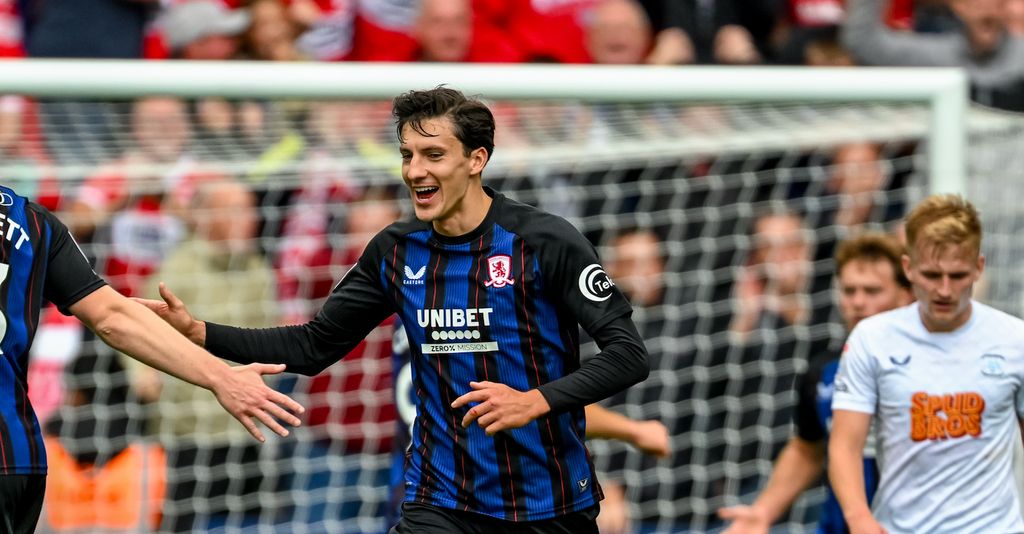Prospective commit Alfie Jones an example of changing reality for CanMNT dual nationals

Another prospective dual national has appeared on the CanMNT’s radar, as The Athletic’s Joshua Kloke reported this weekend that Middlesbrough centre back, Alfie Jones, is currently being courted by CanMNT head coach Jesse Marsch and Canada Soccer.
Naturally, this report was met with some fanfare, given that it comes just a week after Canada’s main centre back, Moïse Bombito, was ruled out for a few months with a leg fracture.
DUAL-NAT UPDATE 🔎@joshuakloke of The Athletic reports Middlesborough CB Alfie Jones could be an option for the CanMNT 🇨🇦 pic.twitter.com/bp6baYdckv
— OneSoccer (@onesoccer) October 14, 2025
With Bombito unlikely to return to the Canadian fold until the March window, leaving him little run-up in the race towards the World Cup, that left Marsch’s side a bit light in terms of centre-backs, and Jones’s potential arrival could help them fix that.
Certainly, Canada’s centre back situation is far better than what it was a few years ago - even beyond the emergence of Bombito as a high-level defender. Derek Cornelius has also become a high-level option, Luc De Fougerolles has been a great breakout story, and the likes of Joel Waterman, Jamie Knight Lebel and Kamal Miller have all been solid depth.
At the same time, beyond Bombito and Cornelius, there are a lot of question marks with each of the other players; be it their experience, fit in the system, or otherwise.
That’s where Jones is an intriguing option - at 28, he’s certainly got the experience, having racked up over 150 appearances in England’s second tier and over 60 appearances in England’s third tier. Then, in terms of stylistic fit, he appears to be at least a decent option for Marsch’s aggressive defensive system, having been accustomed to the very physical nature of the Championship across his time with Middlesbrough (who he joined this year) and Hull City.
On paper, it’s hard to imagine him displacing either Bombito or Cornelius, at least not in the short-term, but he could immediately push to be a good #3 or #4 on the depth chart - and that’s no small detail, as a player of his calibre would’ve likely been a good #1 or #2 option just a few years ago, showcasing Canada’s growth.
Yet, that’s the important thing to consider with the news of Jones’s potential commitment - he arrives at a very interesting time for this Canadian team. While he’d be a welcome addition on paper, there are other dynamics to consider, such as his fit in a tight-knit group that is less than a year away from co-hosting a World Cup.
Plus, with this being a deeper and more competitive Canadian side than ever before, it won’t be as easy for Jones to just drop in and immediately earn a place - he’ll have to battle to earn a spot.
To that point, though, that’s where an interesting question arises - how high could Jones realistically climb ahead of the World Cup? On balance, he has significantly more experience than the 20-year-old De Fougerolles, who has just 10 appearances as a first-team professional and 10 appearances for the CanMNT, but De Fougerolles has the advantage of having been around this Canadian group for over two years, making him well-acquainted with this team and the system they play.
What that shows, though, is the battle Jones will face over the next few months, should he commit. With Canada’s growth, long gone are the days when players would commit and immediately drop into the starting XI - they’ll have to find their way to break in now.
That’s not a knock on Jones, but more of a reminder of how things are changing for this Canadian team. That’s been shown with some of the players that have debuted for Canada over the last 18 months, such as Niko Sigur, Tani Oluwaseyi, Nathan Saliba, Promise David and Daniel Jebbison - despite all being strong players, it’s taken different amounts of time for each player to become regulars in Marsch’s team (and some are still battling for minutes).
Because of that, it leads to the next thing to watch with Jones - when he’ll be eligible to join. Per Kloke’s reporting, they’ll hope his paperwork is sorted in time for the November window - if not, he’ll have to wait until the March window. That leaves a tight timeline ahead of the World Cup - after this October window, Canada will have just six matches (two each in November, March and June) before the start of the World Cup, leaving little runway for Jones or anyone new that comes on the radar in the next few months to find their feet.
With Canada also balancing being as prepared as possible for the World Cup, for which they’ll need to figure out their squad and best XI, it leaves little room for rotation and experimentation - Marsch confirmed as much in September. That’s not to say any new prospective player won’t get any opportunity, but they’ll have limited moments to get them - Liam Millar’s 13-minute cameo vs. Australia in his return from a year-long injury layoff is an example of what that could look like.
Of course, while there will be a lot of talk about where Jones could fit in this squad once committed, there’s also the other question to look at - what could he bring to the team?
Interestingly, even though he’s primarily a centre back now, he’s got significant experience as a midfielder, playing over 50 games there, although he’s played there just five times in 158 Championship games (he hasn’t played in League One since 2020-2021).
That is worth noting, though, as that actually makes him a pretty good fit for Marsch’s system, where centre backs are asked to step up and press opposing attackers quite aggressively in a high line, something Bombito, Cornelius and De Fougerolles have all done quite well, in particular. To that point, that’s also likely why Marsch has preferred Waterman over Miller in that battle for minutes - Waterman is a former midfielder, and midfielders are a lot more used to marking players tightly. 
To peel back the numbers, though, Jones has some good stats to dive into - to begin, defensively, when looking at all of his Championship matches he’s played, he’s averaged 11.94 duels (winning 58% of them), including 4.33 aerials (at a 55.3% rate), to go along with 4.56 interceptions and 10.24 recoveries (all stats per 90, via WyScout).
That’s encouraging, as Marsch’s centre-backs are expected to contest a lot of duels, while having the awareness to make interceptions and recoveries, something Jones seems quite capable of doing based on those figures.
Plus, when considering his strength in the air (which makes sense given his 6’3” frame), that’s a bonus, as Canada’s high press forces a lot of teams to go long, leading to a lot of aerial duels for their centre backs.
Of course, for the modern centre back, what’s done off the ball is half the battle - they also must be solid on the ball. That’s where Bombito, Cornelius and De Fougerolles have also been assets, and where Waterman and Miller are both strong.
Finished like a seasoned striker 🎯
— Middlesbrough FC (@Boro) August 17, 2025
Alfie Jones is off the mark in a Boro shirt 👏 pic.twitter.com/reOAdLBkMG
To Jones’s credit, though, his numbers are solid - he averages 55.82 passes (at a 89.5% clip), including 6.69 long balls (at a 54.5% clip), 5.72 passes to the final third (at a 65.5% clip) and 21.6 forward passes (at a 78.8% clip), indicating solid ball-playing ability. He’s not a big dribbler (he has low dribbling and progressive run numbers), but he can get the ball forward at a decent rate, which is an asset. 
Here are Jones's stats from the 2024-2025 season with Hull City - as seen here, he was a strong ball progressor, even if his defensive stats didn't pop as much compared to his peers (WyScout).
Therefore, when looking at that, there’s a lot to like with Jones’s profile, showing why Marsch will have been intrigued by the possibility of bringing him into the fold. When factoring those in, along with his experience and profile, and the fact that the Championship rates similarly to the Belgian league (where De Fougerolles plays) and is a lot stronger than the Scottish league (where Cornelius plays, albeit at one of the two stronger teams in the circuit), you can see why Jones is an attractive dual national candidate.
Best case scenario, this indicates that he could potentially challenge to earn a starting spot alongside Bombito when everyone is healthy, and worst case scenario, he’s still a very capable #4 - either situation benefits Canada.
Now, though, it remains to be seen what level he’ll hit with such a short runway towards the World Cup, but at the very least, his potential arrival will increase competition at a position where it wouldn’t hurt Canada to have more of that - and that’s a key win.
Yet, that’s the new reality of dual nationals - instead of papering cracks, as was the case before, each new potential addition can only strengthen the foundation, and Jones can do that. Whether or not he’ll be able to become a key piece remains to be seen, especially ahead of the World Cup, but even if he doesn’t, he could also potentially strengthen a post-World Cup Canadian side that will still have big ambitions heading into the rest of this decade, which is another thing to remember with dual nationals - their impact isn’t just felt in the short-term, but further down the road, too.

